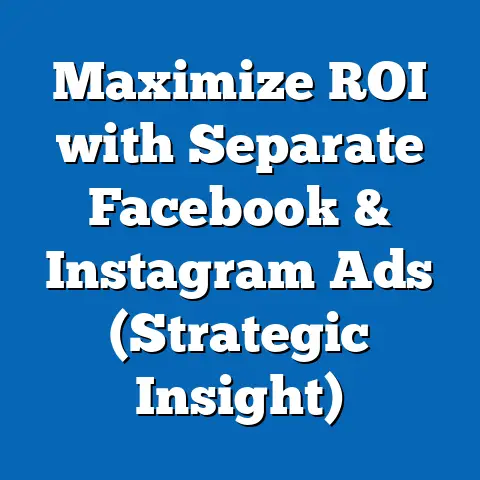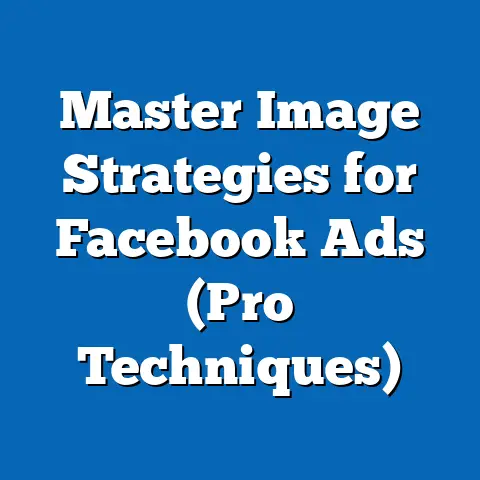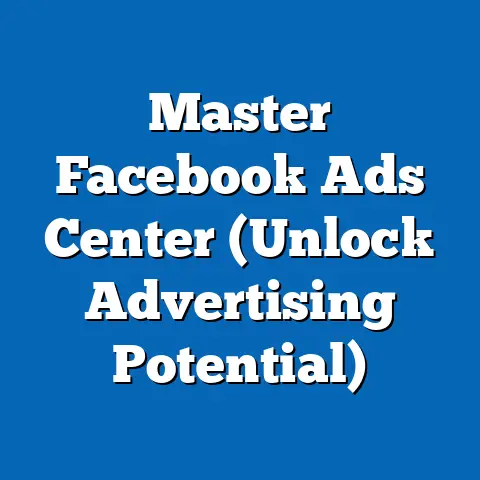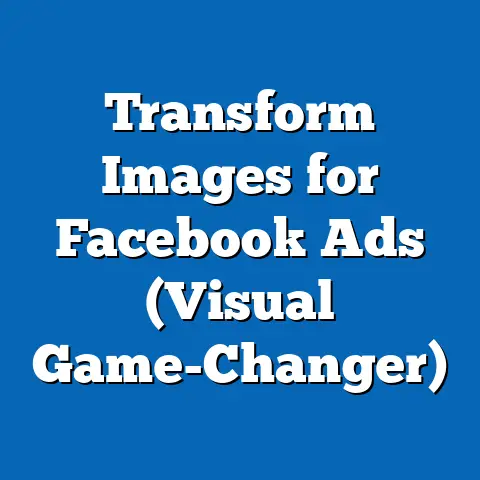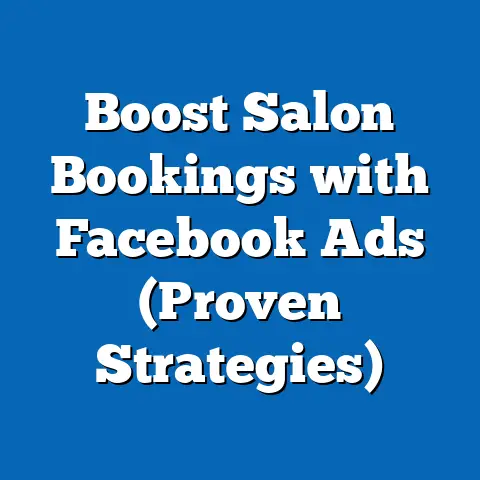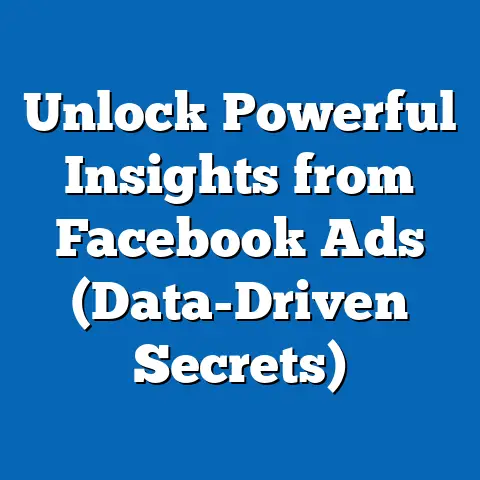Unlock Growth with Facebook & Instagram Ads (Proven Strategies)
Unlock Growth with Facebook & Instagram Ads: Proven Strategies
In today’s digital landscape, social media advertising is no longer just a “nice-to-have” – it’s a necessity. You’re probably already familiar with the direct benefits, like increased website traffic and immediate sales. But what if I told you that Facebook and Instagram ads offer a treasure trove of hidden benefits that can significantly impact your business growth? I’m talking about things like boosting brand awareness, gathering invaluable customer insights, and even building a thriving community around your brand.
I’ve spent years navigating the ever-changing waters of social media advertising, and I’ve seen firsthand how these platforms can transform businesses. It’s not just about throwing money at ads and hoping for the best. It’s about understanding the nuances, leveraging the right strategies, and continuously optimizing your approach.
In this article, I’m going to share my proven strategies for harnessing these hidden benefits and unlocking real growth for your business using Facebook and Instagram ads. Whether you’re a seasoned marketer or just starting out, you’ll find actionable insights that you can implement right away. So, let’s get started!
1: Understanding the Power of Facebook and Instagram Ads
Let’s be honest, the sheer scale of Facebook and Instagram can be overwhelming. But that’s also where their power lies. Combined, these platforms boast billions of active users worldwide, representing a diverse range of demographics, interests, and behaviors. In fact, as of 2024, Facebook has nearly 3 billion active monthly users and Instagram has over 2 billion. That’s a massive audience ripe for the taking.
What makes these platforms even more compelling is their sophisticated targeting capabilities. I remember when I first started running Facebook ads, I was blown away by the level of granularity. You can target users based on everything from their age, location, and interests to their job titles, relationship status, and even their purchasing history. This allows you to reach your ideal customer with incredible precision, ensuring that your ad spend is used effectively.
Targeted advertising is the key to unlocking the true potential of Facebook and Instagram ads. Instead of broadcasting your message to a general audience, you can laser-focus your efforts on the people who are most likely to be interested in your products or services.
Take, for example, a local bakery that wants to promote its new line of gluten-free pastries. Instead of running a generic ad campaign, they can target users in their area who have expressed an interest in gluten-free diets, healthy eating, or local food businesses. This ensures that their ads are seen by the right people, increasing the chances of driving traffic to their bakery and generating sales. According to recent studies, businesses that use targeted advertising on Facebook and Instagram see a 50% higher conversion rate compared to those that don’t. That’s a significant difference!
Key Takeaway: Facebook and Instagram offer unparalleled reach and precise targeting capabilities, making them incredibly powerful platforms for advertising.
2: Uncovering Hidden Benefits of Advertising
Beyond the obvious benefits of driving traffic and generating sales, Facebook and Instagram ads offer a wealth of hidden opportunities that can significantly impact your business growth. Let’s explore some of these hidden gems:
Brand Awareness
One of the most underrated benefits of social media advertising is its ability to boost brand awareness. Even if users don’t immediately click on your ads or make a purchase, they’re still being exposed to your brand, your message, and your unique value proposition.
Think of it like planting seeds. The more people see your brand, the more familiar they become with it. Over time, this increased brand recognition can lead to increased trust, loyalty, and ultimately, sales.
I’ve seen this firsthand with several of my clients. One client, a small e-commerce business selling handmade jewelry, initially focused solely on direct sales through their ads. However, after shifting their strategy to prioritize brand awareness, they saw a significant increase in organic traffic to their website and a noticeable boost in overall sales.
They achieved this by creating visually appealing ads that showcased their unique designs and told the story behind their brand. They also ran ads that simply highlighted their brand values and commitment to ethical sourcing. These ads didn’t necessarily drive immediate sales, but they helped to create a positive impression of the brand in the minds of potential customers. And it worked!
A great example of a company that leverages brand awareness advertising is Coca-Cola. Their ads rarely focus on direct sales; instead, they focus on creating emotional connections with their audience and reinforcing their brand values. This strategy has helped them to maintain their position as one of the world’s most recognizable and beloved brands.
Customer Insights
Facebook and Instagram ads provide a goldmine of data on customer preferences, behaviors, and demographics. By carefully analyzing this data, you can gain valuable insights into your target audience and tailor your marketing strategies accordingly.
The Facebook Ads Manager offers a wealth of analytics, including information on ad performance, audience demographics, and website conversions. You can use this data to understand which ads are resonating with your audience, which demographics are most responsive to your messaging, and which website pages are driving the most conversions.
I remember working with a client who was struggling to understand why their website conversion rates were so low. After analyzing their Facebook Ads data, we discovered that a significant portion of their website traffic was coming from users in a demographic that wasn’t their ideal customer. This insight allowed them to refine their targeting and focus their efforts on reaching the right audience, resulting in a dramatic increase in conversion rates.
Moreover, Facebook Pixel is a game-changer. By installing this code on your website, you can track user actions, such as page views, add-to-carts, and purchases, and use this data to create retargeting campaigns and optimize your ad spend.
Beyond just numbers, pay attention to the comments and interactions on your ads. What are people saying about your product? What questions are they asking? This qualitative feedback can provide invaluable insights into customer needs and pain points.
Community Building
Social media advertising isn’t just about broadcasting your message to the masses; it’s also about fostering engagement and building a thriving community around your brand. By creating ads that encourage interaction and conversation, you can create a loyal customer base that is passionate about your products or services.
One of the most effective ways to build community through ads is to ask questions, run polls, or host contests. This encourages users to engage with your ads and share their thoughts and opinions. I’ve seen brands get a lot of traction by asking their audiences what kind of new products they’d like to see.
I worked with a local coffee shop that wanted to increase engagement on their Facebook page. They ran a contest asking users to submit their favorite coffee recipes, with the winner receiving a free bag of coffee beans. The contest generated a huge amount of engagement, with hundreds of users submitting recipes and sharing the contest with their friends. This not only increased awareness of the coffee shop but also created a sense of community among its customers.
Another effective strategy is to create ads that highlight your brand values and social mission. This can help to attract customers who share your values and are passionate about supporting businesses that make a positive impact on the world.
Patagonia, for example, is a brand that has successfully built a strong community around its brand by highlighting its commitment to environmental sustainability. Their ads often feature stories of environmental activism and encourage customers to join them in their efforts to protect the planet.
Key Takeaway: Facebook and Instagram ads offer hidden benefits such as boosting brand awareness, gathering customer insights, and building a thriving community around your brand.
3: Proven Strategies for Effective Ads
Now that we’ve explored the hidden benefits of Facebook and Instagram ads, let’s dive into some proven strategies for creating effective campaigns that deliver real results.
Target Audiences
As I mentioned earlier, targeted advertising is the key to unlocking the true potential of Facebook and Instagram ads. But how do you create effective target audiences?
First, start by defining your ideal customer. Who are they? What are their demographics? What are their interests? What are their pain points? The more specific you can be, the better.
Once you have a clear picture of your ideal customer, you can use Facebook’s targeting options to reach them. Facebook offers a variety of targeting options, including:
- Demographics: Target users based on age, gender, location, education, job title, relationship status, and more.
- Interests: Target users based on their interests, hobbies, and activities.
- Behaviors: Target users based on their online behavior, such as their purchasing history, website visits, and app usage.
- Custom Audiences: Create custom audiences by uploading a list of your existing customers or website visitors.
- Lookalike Audiences: Create lookalike audiences based on your existing customers or website visitors. Facebook will find users who share similar characteristics and behaviors with your existing customers.
Custom Audiences and Lookalike Audiences are two of the most powerful targeting options available on Facebook. Custom Audiences allow you to reach your existing customers with targeted ads, while Lookalike Audiences allow you to expand your reach to new potential customers who are similar to your existing ones.
I’ve seen incredible results with Lookalike Audiences. One client, a subscription box service, used Lookalike Audiences to increase their subscriber base by 50% in just three months. They created a Lookalike Audience based on their existing subscribers and targeted them with ads that highlighted the benefits of their subscription box.
When creating Lookalike Audiences, it’s important to experiment with different seed audiences. Try creating Lookalike Audiences based on your best customers, your most engaged users, or your website visitors who have completed a specific action, such as signing up for your email list or making a purchase.
Compelling Ad Creative
Even the most perfectly targeted ad will fail if it doesn’t have compelling creative. Your ad creative is what grabs users’ attention and convinces them to take action.
When creating ad creative, keep the following in mind:
- Visuals: Use high-quality images or videos that are visually appealing and relevant to your target audience.
- Headlines: Write clear, concise, and attention-grabbing headlines that highlight the benefits of your product or service.
- Copy: Write persuasive ad copy that speaks to your target audience’s needs and pain points.
- Call to Action (CTA): Include a clear and compelling CTA that tells users what you want them to do next.
Your visuals should be eye-catching and relevant to your target audience. Use high-quality images or videos that showcase your product or service in the best possible light.
Your headlines should be clear, concise, and attention-grabbing. Use strong verbs and highlight the benefits of your product or service. For example, instead of saying “Learn more about our product,” try “Discover how our product can solve your problem.”
Your ad copy should be persuasive and speak to your target audience’s needs and pain points. Use storytelling to connect with your audience on an emotional level and highlight the unique value proposition of your product or service.
Your CTA should be clear and compelling. Tell users exactly what you want them to do next. For example, “Shop Now,” “Learn More,” “Sign Up,” or “Get a Free Quote.”
I’ve found that using customer testimonials in ad creative can be incredibly effective. Hearing from real customers who have had positive experiences with your product or service can build trust and credibility and convince others to give it a try.
Ad Formats
Facebook and Instagram offer a variety of ad formats to choose from, each with its own unique strengths and weaknesses. Some of the most popular ad formats include:
- Image Ads: Simple and versatile, image ads are a great way to showcase your product or service with a visually appealing image.
- Video Ads: Engaging and dynamic, video ads are a great way to tell your brand story and capture users’ attention.
- Carousel Ads: Allow you to showcase multiple images or videos in a single ad, making them ideal for showcasing a range of products or features.
- Collection Ads: Designed for e-commerce businesses, collection ads allow you to showcase a catalog of products in a visually appealing format.
- Stories Ads: Immersive and engaging, Stories ads are a great way to reach users in a casual and authentic way.
The best ad format for you will depend on your goals, your target audience, and your creative assets. Experiment with different ad formats to see what works best for you.
For example, if you’re an e-commerce business, you might want to focus on collection ads and carousel ads, which allow you to showcase a range of products in a visually appealing format. If you’re a service-based business, you might want to focus on video ads, which allow you to tell your brand story and connect with your audience on an emotional level.
A/B Testing
A/B testing, also known as split testing, is the process of testing different variations of your ads to see which ones perform best. This is an essential part of optimizing your ad campaigns and maximizing your ROI.
When A/B testing, it’s important to test only one element at a time. For example, you might test different headlines, different images, or different CTAs. This allows you to isolate the impact of each element and understand what resonates best with your audience.
Facebook Ads Manager makes A/B testing incredibly easy. You can create multiple ad sets with different variations and let Facebook automatically distribute your budget to the winning variation.
I recommend A/B testing everything from your targeting to your creative to your bidding strategies. The more you test, the more you’ll learn about your audience and what works best for them.
One of the most common A/B tests is to test different headlines. Try testing different lengths, different tones, and different value propositions. See which headlines generate the most clicks and conversions.
Budgeting and Bidding Strategies
Setting the right budget and choosing the right bidding strategy is crucial for maximizing your ROI on Facebook and Instagram ads.
Facebook offers a variety of budgeting options, including:
- Daily Budget: Set a fixed amount that you’re willing to spend each day.
- Lifetime Budget: Set a fixed amount that you’re willing to spend over the entire duration of your campaign.
The best budgeting option for you will depend on your goals and your campaign duration. If you’re running a short-term campaign, a lifetime budget might be the best option. If you’re running a long-term campaign, a daily budget might be more appropriate.
Facebook also offers a variety of bidding strategies, including:
- Lowest Cost: Facebook will automatically bid to get you the most results for your budget.
- Cost Cap: You set a target cost per result, and Facebook will bid to stay within that cost.
- Bid Cap: You set a maximum bid for each auction, and Facebook will never bid higher than that amount.
- Target Cost: Facebook will aim to get you the most results at your target cost per result.
The best bidding strategy for you will depend on your goals and your campaign objectives. If you’re focused on maximizing reach and brand awareness, the lowest cost bidding strategy might be the best option. If you’re focused on driving conversions at a specific cost, the cost cap or target cost bidding strategies might be more appropriate.
It’s important to monitor your ad spend and adjust your budget and bidding strategy as needed. If you’re not seeing the results you want, try increasing your budget or switching to a different bidding strategy.
Key Takeaway: Proven strategies for effective ads include precise target audiences, compelling ad creative, strategic use of ad formats, consistent A/B testing, and smart budgeting and bidding strategies.
4: Measuring Success and Making Adjustments
Running Facebook and Instagram ads is not a “set it and forget it” activity. It requires ongoing monitoring, analysis, and optimization.
The first step is to define your key performance indicators (KPIs). What metrics are most important to you? Are you focused on driving traffic, generating leads, or increasing sales?
Some common KPIs for Facebook and Instagram ads include:
- Click-Through Rate (CTR): The percentage of users who click on your ad after seeing it.
- Conversion Rate: The percentage of users who complete a desired action after clicking on your ad, such as making a purchase or signing up for your email list.
- Cost Per Click (CPC): The average cost you pay each time someone clicks on your ad.
- Cost Per Conversion (CPC): The average cost you pay each time someone completes a desired action after clicking on your ad.
- Return on Ad Spend (ROAS): The amount of revenue you generate for every dollar you spend on ads.
- Engagement Metrics: Likes, comments, shares, and other interactions with your ads.
Use Facebook Ads Manager to track your KPIs and monitor your ad performance. Pay attention to trends and identify areas for improvement.
For example, if your CTR is low, it might be a sign that your ad creative isn’t compelling enough. Try testing different headlines, images, or CTAs.
If your conversion rate is low, it might be a sign that your landing page isn’t optimized for conversions. Make sure your landing page is relevant to your ad, has a clear CTA, and is easy to navigate.
It’s also important to stay updated with Facebook and Instagram algorithm changes. These platforms are constantly evolving, and what worked yesterday might not work today.
Follow industry blogs, attend webinars, and join online communities to stay informed about the latest trends and best practices.
I remember when Facebook made a major algorithm change that significantly impacted organic reach. Many businesses saw a dramatic decline in their organic traffic, and they had to adjust their strategies accordingly.
The key is to be adaptable and willing to experiment. Don’t be afraid to try new things and see what works for you.
Key Takeaway: Measuring the success of your ads and making data-driven adjustments is crucial for continuous improvement and maximizing your ROI.
Conclusion
Facebook and Instagram ads offer a wealth of opportunities for businesses of all sizes. Beyond the obvious benefits of driving traffic and generating sales, these platforms can help you boost brand awareness, gather valuable customer insights, and build a thriving community around your brand.
By implementing the proven strategies outlined in this article, you can unlock the hidden potential of Facebook and Instagram ads and achieve real growth for your business.
Remember to focus on targeted advertising, compelling ad creative, strategic ad formats, consistent A/B testing, and smart budgeting and bidding strategies. And don’t forget to monitor your ad performance and make data-driven adjustments as needed.
The world of social media advertising is constantly evolving, so it’s important to stay informed, be adaptable, and never stop learning. With the right strategies and a little bit of effort, you can harness the power of Facebook and Instagram ads to transform your business.
So, what are you waiting for? It’s time to take action and unlock the transformative potential of social media advertising for your business!

